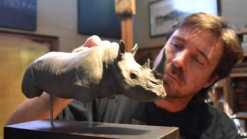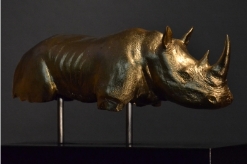
A legacy for the African rhino
Despite the many attempts to curb rhino poaching and the dedicated activism from the public, the slaughter of these beasts continues, with the death toll for 2012 approaching 450 animals. This has not halted the efforts of South Africans. South African artist, scientist and conservationist Noel Ashton has sculpted a series of rhino sculptures titled Mapungubwe Revisited. The […]


Despite the many attempts to curb rhino poaching and the dedicated activism from the public, the slaughter of these beasts continues, with the death toll for 2012 approaching 450 animals. This has not halted the efforts of South Africans.
South African artist, scientist and conservationist Noel Ashton has sculpted a series of rhino sculptures titled Mapungubwe Revisited. The series is a limited edition, consisting of 12 gold and 100 bronze rhino castings, and is the artist’s way of honouring the magnificence of Africa’s wildlife heritage.
In the past Ashton has initiated other conservation programmes for Africa’s wildlife, most of which he has dedicated to whales.
“Throughout the years we have engaged in a range of conservation programmes by combining artworks, narratives and our commitment to the earth,” Ashton says.

(Images: Noel Ashton Wildlife Studio)
Mapungubwe Revisited
Mapungubwe Revisited was inspired by the discovery of a small 152-millimetre long rhino made of pure gold, in the grave of the king of the ancient realm of Mapungubwe, situated in Limpopo province. The golden rhino was buried with the king over 800 years ago, showing that rhinos were revered by African royalty.
“The artwork speaks through time, and as an artist I see its significance as a symbol of the rich cultural legacy of Africa,” says Ashton in an interview.
The golden rhino, according to Ashton, embodies a deeper connection with, and reverence for this magnificent animal of Africa. It links all African people to the land through a sacred thread of belonging.
“The golden rhino offers a signpost to something that we might have forgotten but fortunately not lost; it can remind us that the natural world around us is much more than a commodity, a space or a view, it is an intrinsic part of who we are and where we have come from, and each rhino killed or tract of land destroyed is another part of ourselves lost,” he says.
By investing in a limited-edition sculpture of Mapungubwe Revisited, buyers will be contributing towards the conservation of the species. The gold and bronze sculptures cost R35 000 (US $4000) and R15 000 ($1700) respectively, and funds from the sale of each sculpture are donated towards the South African chapter of the World Wide Fund for Nature (WWF-SA) and its rhino conservation work.
Taking back our heritage
As illustrated by the Mapungubwe gold rhino, the animals have long been an object of value in African culture. South Africans are rightly proud of their rhino history and the critical role they played in the remarkable recovery of white rhino numbers over the last century. Today three out of every four rhinos alive, 75% of the world’s rhinos, are found in South Africa.
“After being severely threatened in the earlier part of the 20th century, African conservationists have worked tirelessly over the past two decades to nurture faltering populations back to healthy and vibrantly growing numbers,” said WWF-SA CEO Morne du Plessis in a statement.
In their continued commitment to the rhinos, the Shamwari hospitality group has produced a Celebrity Ambassador Rhino Calendar to help raise awareness for the plight of the rhinos, as well as much needed funds.
The calendar was launched on 21 September in Camps Bay, Cape Town, and also has the support of the Wilderness Foundation and conservation veteran Dr Ian Player.
“Since launching the calendar and celebrating World Rhino Day, 10 more rhinos have been slaughtered and time is running out for this living dinosaur,” says Tom Jäger, Shamwari’s group sales and marketing manager.
Celebrities join the frontline
Celebrities such as South African model Josie Borain, former Miss South Africa Bernelee Daniell, Glamour Magazine editor Pnina Fenster, television personality Katlego Maboe, comedian Irit Noble and Zimbabwean model Sam Pegg offered their time to the creation of the calendar.
The photo shoot took place at Sanbona Wildlife Reserve outside Cape Town by renowned photographer Andrew Brown, who also donated his time to the cause.
The calendars will at first be available for purchase at the Shamwari properties of Sanbona Wildlife Reserve near Cape Town, Shamwari Game Reserve in the Eastern Cape and Jock Safari Lodge in the Kruger National Park.
The cost of the calendar is R150 ($17), and all proceeds will go to the Wilderness Foundation through the Shamwari Group’s Forever Wild Campaign, which has already during the course of 2012 raised just over R240 000 ($28 000) for rhino awareness and protection.
“If we all stand together and create a unified response whilst educating this generation and future generations, including the poachers, this slaughter will come to an end,” said Shamwari GM Joe Cloete, in a statement.
“We are proud to have created the calendar and to be able to also give guests an opportunity to spread the word and support the Wilderness Foundation in all their endeavours.”
A perpetual reminder
The calendar is everlasting, making it reusable every year as it is not restricted to the day or month. Each month presents a different photo of a celebrity ambassador, and Shamwari game rangers, wildlife and properties alongside a relevant quote.
As many of us spend most of our lives behind a desk, the Shamwari team thought a perpetual calendar would be practical, informative and useful.
“During a brainstorm session about how we could help even more with the critical situation facing rhinos, we knew we wanted to do something that would not only raise awareness and funds regarding the plight of the rhino but something that could be an everyday reminder,” says Jäger.
A selection of Shamwari photos were taken by IKY’s Photographic.
The sponsors for this initiative include Camera Ready, Black Orchid, The Paper Shop, Paper Smith and Sons, the Sunshine Co, Grand Café and Room in Camps Bay and the Wilderness Foundation.
By: Cadine Pillay
Source: www.mediaclubsouthafrica.com
